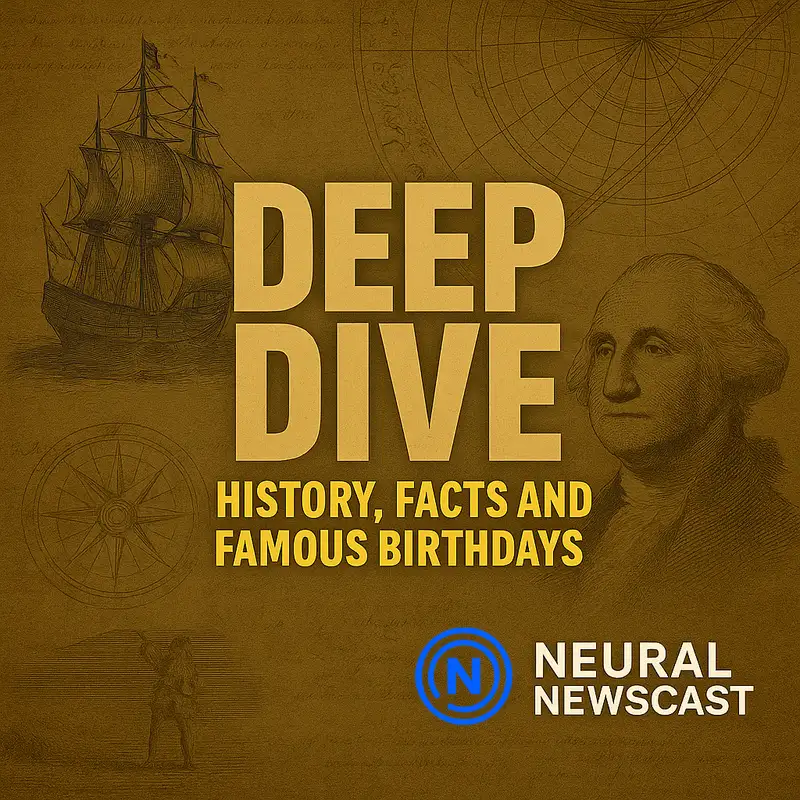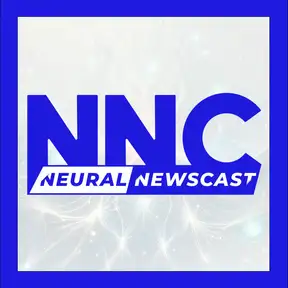Deep Dive: Moons, Machines, and Main Street: Mars’ Tiny Satellites, Ada Lovelace, and a Town Transformed - August 12, 2025
Experience the news on NNC, Neural Newscast.
Thanks for joining us for this neural newscast deep dive.
I'm Andrew, and alongside Monica, we're about to uncover some intriguing stories.
August 1877, Asaph Hall from the Naval Observatory,
peering through a telescope and announcing that Mars had not one, but two tiny moons,
Deimos and Phobos.
that moment reshaped how people pictured our place in the solar system.
And it's easy to forget how seismic that was.
Until Hall's measurements, moons beyond Earth's were theoretical possibilities,
not confirmed realities.
Suddenly, another planet had companions,
changing scientific and even cultural conversations worldwide.
Right, and Hall's method matters.
Patient, methodical observation over nights,
tracking faint points of light against background stars,
triangulating orbits,
This wasn't a flash of luck so much as relentless, careful work.
He had to subtract reflections, instrument quirks, the haze of Earth's atmosphere,
and then there's the human element, the skepticism he faced,
the need to publish precise positions and convince a cautious community, diplomacy of data in a way.
Hall, naming them Deimos in Phobos, terror and panic in Greek, gave the discovery drama too.
Those names spoke to Mars, warlike mythology, and suddenly, textbooks, newspapers and artists had new symbols to work with.
It affected more than astronomy.
International observatories compared notes.
Telescopes were calibrated differently, and navies and cartographers began to think about celestial mechanics with fresh urgency.
Even geopolitics can hinge on scientific credibility.
There's also the technical leap.
Finding such tiny, fast-orbiting bodies close to Mars required resolving power at the limits of 19th-century optics,
an achievement that nudged telescope design and observational technique forward.
And consider the ripple effects.
Future missions, of course, owe a debt to Hall's confirmation.
Trajectory planners, planetary scientists, even science fiction writers,
used those moons as plot devices and as test cases for thinking about moons as environments.
It's striking that Phobos and Deimos are so different from our moon.
Irregular, likely captured asteroids.
that raised new questions about planetary formation and migration,
and about how dynamic our solar system truly is.
Exactly, and that led to debates about capture theory versus co-formation.
Forcing models of orbital dynamics to account for near-planet captures
and the influence of tidal forces,
it reshaped theoretical work as much as observational practice.
Hall's personal story threads through this too.
a relatively quiet astronomer who'd trained under giants,
suddenly at the center of a discovery that made headlines around the world.
the human scale makes the science more vivid.
He wasn't working in isolation, assistance, observatory funding,
the international exchange of measurements.
It was an ecosystem.
That collaborative infrastructure is a pattern we still rely on for breakthroughs.
Looking back, the announcement in 1877 also arrived at a moment when public imagination was primed.
Telescopic discoveries made headlines, lectures filled halls.
people were ready to wonder, and Hall gave them something tangible to wonder about.
And that wonder had practical consequences, spurring investment in astronomy,
inspiring young scientists, and seeding long-term projects that a century later would send probes to those very moons.
A clear line from a nightside observation to interplanetary exploration.
So when we marked that day, it's not just a footnote about two small bodies orbiting Mars.
It's a story about technique,
skepticism overcome, international scientific dialogue,
and how a single discovery can realign multiple fields.
Which is why, even now, scholars and mission planners reference Hall's work.
It reminds us that careful observation, persistent inquiry,
and the willingness to share and test results are the engines of discovery.
Today we celebrate the birthdays of Ada Loveless, 1815.
Nikola Tesla, 1856, and Grace Hopper, 1906.
Focusing in, let's talk about Ada Lovelace.
Her life reads like the hinge between poetry and engineering,
and she's often called the first computer programmer.
Right, and that phrase isn't just rhetorical.
In the 1840s, she wrote algorithms for Charles Babbage's analytical engine
that anticipated key concepts of computing long before electronic machines existed.
What I find fascinating is how her background shaped that insight.
Daughter of Lord Byron and a rigorous mathematician mother,
who insisted on a scientific education to counteract poetic excess.
That tension mattered.
Her notes show she thought about machines not only calculating numbers but manipulating symbols.
a leap toward thinking about software conceptually.
She also translated an Italian paper by Luigi Menebrae and appended her own extensive notes,
labeled a through G, and it's note G that contains the algorithm for computing Bernoulli numbers.
And she included meta-observations. For instance,
imagining a machine composing elaborate music if programmed with the right rules.
That presaged modern computational creativity.
A lesser-known fact, Ada suffered from chronic illness and used Laudnam at times,
yet she maintained a fierce correspondence with scientists and aristocrats across Europe,
which broadened her intellectual reach.
Her friendship with Babbage was complex too,
She championed his vision even when contemporaries dismissed it,
and she provided the public with one of the clearest expositions of his machine's potential.
There's an irony in her being sidelined for decades.
Early computing pioneers often cited men who came later,
but her status has been restored as historians reassess those original texts.
Another intriguing detail.
Ada's notion that machines could manipulate symbols in accordance with rules,
but could not originate meaning,
She understood limits, yet left open the possibility that complexity might blur that boundary.
That philosophical nuance feeds today's debates about artificial intelligence,
can a machine create meaning or only recombine human-given rules.
Ada's century-old notes still echo in that conversation.
Her death at 36 was sad and abrupt, but she packed a lifetime of intellectual risk into
relatively few years, and her correspondence preserves a mind constantly reaching beyond
the technical into the conceptual.
And on a personal level, she managed salons, parenting and scientific work, navigating
19th century social expectations while forging a professional identity that social context
makes her achievements even more impressive.
Her legacy then is twofold.
foundational technical insight and a model of interdisciplinarity, poetry, math, engineering,
that encourages cross-pollination in innovation.
Exactly, and as computing becomes ubiquitous, remembering Ada reminds us to pair technical prowess with imagination
and to ask what we want those machines to do for society.
Her life still matters because it reframes how we think about origins, not as single inventions, but as conversations across disciplines and generations.
Today on her birthday, that conversation continues.
Researchers, historians, and technologists still find guidance in her curiosity and careful thinking.
We'll be right back after this short break.
This is Neural Newscast, where machine learning meets meaningful reporting.
All stories are reviewed for accuracy before release.
Find our full archive at neuralnewscast.com.
And we're back with more from Neural Newscast Deep Dive.
So his hometown literally went to pot.
The little Midwestern town that used to be all cornfields and church socials
is now dotted with dispensaries and hemp warehouses.
That's a story that reads like a cultural pivot in miniature.
It's a striking image, Andrew, because we usually talk about national policy shifts,
but this is the local fallout or flourish, depending on your view.
Businesses transforming Main Street, tax revenues changing budgets,
and even zoning laws rewritten overnight.
Exactly. And what's compelling is how quickly the ground shifted.
one election or one change in state law, and suddenly the economic calculus for small towns flips from stagnation to new investment,
with both promise and complications.
Complications like the social fabric, long-time residents who remember bank sales and parades now seeing storefronts with neon open signs for cannabis,
that alters community identity and it forces conversations about who benefits and who gets left behind.
There's also the pragmatic side. Municipal leaders who had been desperate for revenue, now juggling infrastructure needs, public safety and licensing.
They become policymakers overnight, and their choices set precedents for neighboring towns.
And don't forget the international angle, oddly enough, agricultural exports,
hemp supply chains. Even foreign investment can be affected when a region embraces cannabis-related
crops. The ripple effects reach beyond state lines.
That ripple is visible in job creation statistics too.
Growers, lab technicians, retail staff, roles that didn't exist a decade ago.
But many of those jobs are seasonal or conditional on federal policy remaining permissive, which makes planning risky.
Risky is right and there's social risk too.
Youth perceptions shift, enforcement priorities change, and law enforcement resources get reallocated.
Communities wrestle with public health messaging while also courting economic development.
Which makes the human stories vital.
You have former factory workers retraining as master grower apprentices,
and entrepreneurs converting abandoned storefronts into boutique dispensaries.
It's a kind of reinvention. Messy, but real.
And you see a generational split.
Younger residents often celebrate the new industry as progress and opportunity.
While older generations worry about character and safety,
both perspectives have merit and neither is likely to disappear quickly.
Politically, it's fascinating too.
Politicians who opposed legalization find themselves negotiating licenses for a local donor base,
while proponents must manage the outcomes they promised, and that tension fuels local elections.
Which returns us to the point about governance.
Town councils and planning boards suddenly have to become experts in agricultural regulation,
public health, and commercial real estate.
It's governance by necessity, not by design.
So when we say his hometown went to pot,
it's shorthand for a profound, layered transformation,
economic, social, political, that forces communities
to confront the future in tangible, often uncomfortable ways.
And the lesson for other towns watching?
There's opportunity, yes, but also a need
for deliberate policy, community engagement,
and long-term planning.
Otherwise, the boom becomes a boom and bust
with real human costs.
We hope you enjoyed this deep dive.
From Andrew and all of us at Neural Newscast, I'm Monica.
Join us next time.
From daily summaries to deep storytelling, Neural Newscast keeps you informed.
Visit neuralnewscast.com.
For more ways to listen and explore,
Neural Newscast merges real and AI-generated voices
to ensure rapid, high-quality news production.
Our content is created using advanced AI models and rigorously reviewed by humans for accuracy and fairness.
Despite efforts to prevent AI errors, occasional inaccuracies may occur.
We encourage listeners to cross-check critical details with trusted sources.
Read about our AI transparency at nnewscast.com.
Creators and Guests


